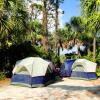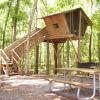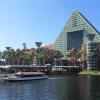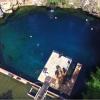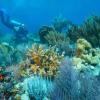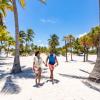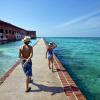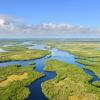By Janet K. Keeler
The question of where to see alligators in Florida might be better phrased, where don’t you see alligators in Florida?
The ancient reptiles sun themselves on golf courses, inhabit wildlife theme parks, cruise around freshwater lakes, rule the Everglades and occasionally hit the news when they stroll through subdivisions.
In short, American alligators – some 1.3 million of them – are all over the state. And you’ll have plenty of places in captivity or the wild to choose from when you set out to observe some of the remaining creatures of the dinosaur age.
Gators were once on the brink of extinction in the Sunshine State, but aggressive conservation efforts reversed their decline. The prehistoric reptiles are an important part of the state’s ecosystem. For example, the “gator holes” where they collect food and occasionally sleep, hold water in the dry season, creating places of refuge and sustenance for fish, insects, snakes, turtles and birds.
A caveat to those who want to see gators in their natural habitats (and we are not talking football players at the University of Florida): Don’t feed them. That is illegal and can condition them to associate food with people.
Also, keep your distance. The Florida Fish and Wildlife Conservation Commission recommends we stay at least 60 feet away when observing in the wild. The state’s Living with Alligators page provides more useful tips.
Winter is the best season for alligator watching, mostly because they come out of the cooler water to catch the warm rays. Spring is breeding season and the low growls of amorous males fill the air.
Here are some of the best places to see alligators in Florida:
How can you see alligators in the Everglades? Let us count the ways. This World Heritage Site is billed as “the largest subtropical wilderness in the United States,” and there are loads of gators living here. The main entrance is in Homestead, and that leads to the Flamingo Visitor Center and the Ernest F. Coe Visitor Center. Alligators are often spied from the walking trails.
The Shark Valley entrance is on U.S. 41 Tamiami Trail, in Miami. Here, you can take tram tours and rent bicycles to ride on the paths. Either way, you’re guaranteed to see some big guys. Climb the Shark Valley tower at the visitors center to get a bird’s-eye view of the amazing “river of grass.”
The two highways through the Everglades and across the state are Interstate 75 (Alligator Alley) and U.S 41 (Tamiami Trail) to its south. Water runs along both sides of the roads, and passengers with keen eyes can spy gators swimming along or sunning on the banks. Bring binoculars.
Along the Tamiami Trail, which runs through the Miccosukee Indian reservation, are companies offering airboat rides (and sometimes kayak rentals), among them Wooten’s, Tigertail, and Buffalo Tiger. They provide sound mufflers to protect ears from the roar of the motor, and make it a point of getting riders as close as possible to alligators. Billie Swamp Safari in Clewiston, north of Alligator Alley, has swamp buggy tours and airboat rides, plus a twilight expedition. The Everglades Alligator Farm is a great stop for travelers heading to the Florida Keys who want to take an airboat ride and see a wildlife show.
While the Everglades are teeming with gators – about 200,000 – there are many other spots to have a safe encounter.
Wakulla Springs State Park
Wakulla, south of Tallahassee, is one of the world’s largest and deepest freshwater springs. Here you’ll find a large swimming area, a 22-foot diving platform and observation deck, a historic lodge with restaurant and casual café (ice cream!), and boat rides. Ranger-led boat tours take visitors out on the river for about 45 minutes. This a good, multi-generational excursion that provides a gentle experience, plus the boats are handicap accessible. Besides gators, which often are spied sunning next to turtles, you will see all manner of Florida birds. Even if you don’t stay in the lodge, stroll through the lobby and check out Old Joe, an 11-foot taxidermy gator, shot dead by a poacher in 1966.
More State Parks
Myakka River State Park in Sarasota County is a grand spot for alligator watching. There are plenty of gators in the river, which runs through 57 square miles, but the truly adventurous take the easy five-mile round trip hike to Deep Hole, a sinkhole on the edge of the river that attracts dozens of gators. Only 30 daily permits are issued to this wilderness area, and rangers suggest you pick a sunny day with little wind. Gators hide when it’s windy. Call (941) 361-6511 for details. Same-day permits are issued, but try to get to the park by 8 a.m. if you haven’t reserved one, and bring camera, water and sunscreen. It wouldn’t be unusual to see 100 to 120 gators on the banks.
Hillsborough River State Park is natural respite close to Tampa and the urban sprawl of the area. Ride bikes on paths or walk over boardwalks and you’re sure to see a few gators, especially if you paddle the river in canoe or kayak.
Alligator Theme Parks
Gators in captivity are the draw at several places around the state. At these attractions, visitors can observe alligators at feeding times, hold and pet baby gators and also hear expert lectures, plus maybe have some lunch (gator bites anyone?) at cafes or nearby restaurants. This is a way to see alligators in a more organized, controlled fashion.
Among the state’s gator attractions are GatorWorld Parks, in Wildwood, near Orlando. This drive-thru park guides visitors in their cars through the park and past specially designed pools where about 400 gators swim and feed. At the end, there’s a platform to observe and feed the reptiles.
Also in Orlando is Gatorland, a 110-acre theme park that is home to about 2,000 gators. Then there’s the St. Augustine Alligator Farm Zoological Park, where brave souls can zip line over alligators and crocodiles, and Gatorama in Palmdale, east of Lake Okeechobee. Gatorama is an iconic Florida roadside attraction that has been drawing gator-curious tourists since 1957.
Alligator and Wildlife Discovery Center, in Madeira Beach on Florida’s west coast, is a smaller stop that’s good for kids who want to give a gator a smooch, while Jungle Adventures, near Merritt Island on the Space Coast, features all sorts of Florida critters plus a jungle swamp river cruise. Not a theme park exactly, but the Florida Aquarium in Tampa has a wonderful exhibit of baby gators in which they can be spied above and below the water through a glass wall.
Everglades Holiday Park, a wildlife preserve and theme park on 29 acres near Fort Lauderdale, is home for Animal Planet's "Gator Boys" TV show, and features daily gator shows.
Freshwater Lakes
Minnesota calls itself the land of lakes with its 10,000 watery holes, but Florida has about 30,000. You can rest assured that many in the Sunshine State are home to gators.
According to Florida Fish and Wildlife, Lake George, near the St. Johns River in northeast Florida, has the most-- more than 2,300. Lake Kissimmee, near Orlando, comes in second with just shy of 2,000. Seeing gators on the state’s lakes is most likely the experience of fishermen who are on the hunt for bass and sunfish. Lake Kissimmee State Park, 15 miles east of Lake Wales, is an excellent place for campers, birders, paddlers and even RV lovers to get a taste of natural Florida, and that includes gator viewing.
And There’s More
The Audubon's Corkscrew Swamp Sanctuary, in the Western Everglades, is 13,000 acres of natural Florida sited east of Interstate 75 in Collier County and 45 miles northeast of Naples. Corkscrew can be enjoyed by traversing the 2.5-mile elevated boardwalk through pine flatwoods leading to the wet prairie, around a marsh, and finally into the world’s largest remaining virgin bald cypress forest. Keep your eyes peeled for alligators, especially moms and babies.
An elevated one-mile walkway guides visitors through Sawgrass Lake Park, a natural oasis in densely populated Pinellas County in St. Petersburg. Look for gators in the lakes and canals. Merritt Island State Wildlife Refuge, east of Titusville on the Space Coast, is home to many Florida critters, including gators. A visitor center will help you find the best places to spy the prehistoric beasts.
You won’t likely leave the Ocala National Forest, north of Orlando, without seeing a gator or two. Lakes abound and rivers run through the forest, giving alligators plenty of spots to do their thing. Boaters, paddlers and fishermen see plenty.
Gators and Mini-Golf
No, the gators don’t play putt-putt, but for humans who do at Smugglers Cove Adventure Golf, there’s a reptile experience. At five locations along the coast of west Florida, large ponds of baby gators are a big attraction. Lots of golfers start or end their round of miniature golf by feeding the alligators. That might quality for an “only in Florida” label.
PLACES TO REMEMBER
RELATED CONTENT
Wonderful (and Weird) Facts About Florida
- 8 minute read
We come across lots of weird and wonderful Florida facts. So we thought we'd share a few. OK, more than a few. You never know ... these Florida...
8 Florida Destinations for Wildlife and Scenery
- 3 minute read
By Kate Witcher The Sunshine State’s allure includes ecotourism attractions in a stunning variety of locales across the state. Best of all, you...
The Everglades: Joe Wasilewski, the 'Snake Man'
- 3 minute read
By Jeff Klinkenberg The first snake Joe Wasilewski caught as a boy was a little garter snake in Illinois. The last one, a half-century later in the...


